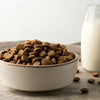How to Store Freeze-Dried Raw Dog Food: Essential Tips for Pet Owners
- Houndsy
Table of Contents
- Introduction
- Understanding Freeze-Dried Dog Food
- Best Practices for Storing Freeze-Dried Dog Food
- The Importance of Proper Storage
- Conclusion
Introduction
Did you know that a staggering 80% of dog owners are increasingly leaning towards freeze-dried raw dog food as a healthier option for their pets? This trend is no surprise, as freeze-dried dog food retains a high nutritional value while offering convenience and longer shelf life. However, proper storage is key to maintaining its quality and ensuring that our furry friends receive the best nutrition possible.
As dedicated pet owners, we often face the challenge of providing our dogs with nutritious meals while ensuring that the food stays fresh for as long as possible. In this blog post, we will explore effective strategies on how to store freeze-dried raw dog food and why these methods are crucial for preserving its quality.
By the end of this article, you'll gain insights into the best practices for storing freeze-dried dog food, helping you enhance your pet's feeding experience. We will cover essential aspects such as understanding the nature of freeze-dried food, optimal storage techniques, and tips to maintain freshness. Let’s dive in and elevate our pet care routine!
Understanding Freeze-Dried Dog Food
Before we delve into storage tips, it’s important to understand what freeze-dried dog food is and why it has become such a popular choice among pet owners. Freeze-drying is a preservation process that removes moisture from food while retaining its nutrients, flavor, and texture. This is accomplished through a methodical three-step process:
- Freezing: The food is rapidly frozen to maintain its cellular structure.
- Vacuum Pressure: The frozen food is placed in a vacuum chamber where the pressure is lowered, causing ice to sublimate directly from solid to vapor.
- Drying: The vapor is removed, yielding dry, lightweight food that retains most of its original nutrients.
This gentle preservation method allows freeze-dried dog food to have a long shelf life—ranging from 2 to 25 years for unopened packages—making it an economical choice for dog owners.
Best Practices for Storing Freeze-Dried Dog Food
Now that we understand the unique characteristics of freeze-dried dog food, let’s explore effective storage methods that will help maintain its quality and nutritional value.
1. Keep It in Original Packaging
One of the simplest ways to store freeze-dried dog food is to keep it in its original resealable packaging. Most freeze-dried dog foods come in bags designed to block light and moisture. After each use, make sure to seal the bag tightly to prevent air from entering. If the original packaging is damaged, transfer the food to an airtight container.
2. Use Airtight Containers
If you choose to transfer the food from its original packaging, opt for an airtight container made from high-quality materials like glass or durable plastic. This will help protect the food from moisture and air, which can lead to spoilage. Additionally, consider using vacuum-sealed containers, as they provide an extra layer of protection against environmental factors.
3. Store in a Cool, Dry Place
Temperature and humidity are critical factors in maintaining the freshness of freeze-dried food. Store it in a cool, dry area of your home, such as a pantry or cupboard, away from direct sunlight and moisture. Avoid areas with temperature fluctuations, like kitchens or near windows. Ideally, the storage temperature should be below 75°F (24°C).
4. Avoid the Refrigerator and Freezer
While it may seem logical to store freeze-dried dog food in the refrigerator or freezer for added freshness, this can actually introduce moisture into the food, leading to spoilage. Instead, aim for a stable room-temperature environment that is both cool and dry.
5. Rotate Your Stock
If you purchase freeze-dried dog food in bulk, practice the "first in, first out" method. This means using older stock first to ensure that nothing goes to waste. Regularly check expiration dates to avoid feeding expired food to your dog.
6. Handle with Care
When handling freeze-dried dog food, always use clean, dry hands or a dedicated scoop to avoid introducing moisture or contaminants. This practice will help maintain the quality of the food and prevent spoilage.
The Importance of Proper Storage
Proper storage not only preserves the freshness and nutritional value of freeze-dried dog food but also protects your pet from potential health risks associated with spoiled food. Exposure to moisture, air, and light can degrade the food, affecting its taste and nutritional quality. By following the storage tips outlined above, we can ensure that our dogs enjoy healthy and delicious meals every time.
The Economic and Environmental Impact
Choosing freeze-dried dog food can also be seen as an economically and environmentally conscious decision. With its long shelf life, you reduce the frequency of purchases and minimize food waste. This not only saves money but also lessens your environmental footprint—fewer trips to the store mean lower emissions and less packaging waste.
Conclusion
In conclusion, understanding how to store freeze-dried raw dog food is essential for ensuring that our beloved pets receive the best nutrition possible. By keeping the food in its original packaging, using airtight containers, and storing it in a cool, dry place, we can preserve its quality and freshness for longer periods.
As we embrace innovative solutions to pet care, consider enhancing your pet feeding routine with the Houndsy Kibble Dispenser. This beautifully designed product not only ensures perfect portion control but also complements modern home decor effortlessly. Explore the Houndsy Kibble Dispenser to simplify your dog feeding experience today!
Frequently Asked Questions
1. Can freeze-dried dog food go bad?
Yes, freeze-dried dog food can spoil if exposed to moisture, heat, or air. Signs of spoilage include mold, bad odors, and changes in texture.
2. How should I store freeze-dried dog food?
Store freeze-dried dog food in its original packaging or in airtight containers in a cool, dry place away from light and moisture.
3. How long can freeze-dried dog food last once opened?
Once opened, freeze-dried dog food is best consumed within 3 to 6 months for optimal freshness.
4. Does freeze-dried dog food retain its nutritional value?
Yes, freeze-dried dog food retains up to 97% of its original nutritional value, making it an excellent choice for pet owners looking for high-quality nutrition.
5. How do I know if my freeze-dried dog food is spoiled?
Check for signs of spoilage, such as unusual odors, visible mold, discoloration, or changes in texture. If in doubt, it’s safer to discard the food.
By following these guidelines and utilizing high-quality products like the Houndsy Kibble Dispenser, we can simplify and elevate our dogs’ feeding experiences while ensuring their health and happiness.












